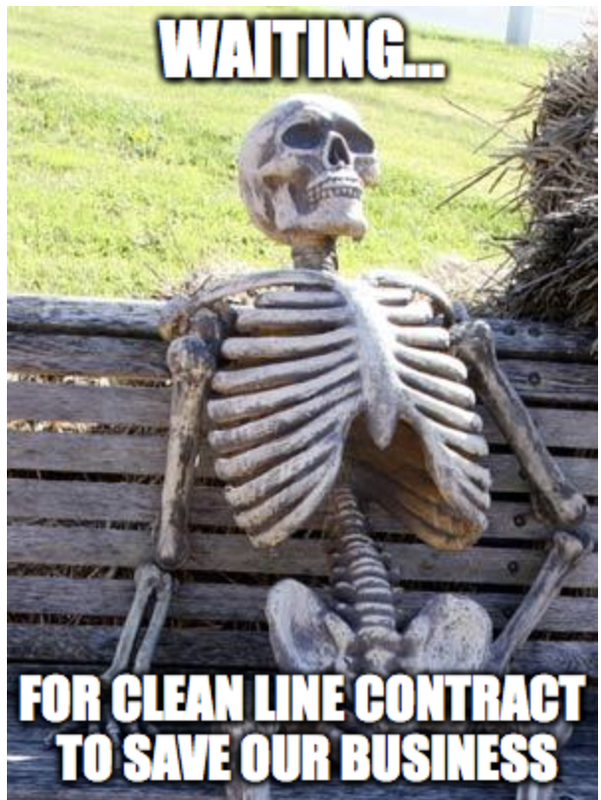The Southern Alliance for Clean Energy is currently running a petition asking the Tennessee Valley Authority to buy a commodity from a company that does not sell that commodity.
We strongly encourage TVA’s board of directors to immediately contract for at least 1,000 megawatts of wind power on the Plains and Eastern Clean Line. We need your help to urge TVA to buy wind power from Clean Line today
Clean Line Energy Partners does not sell electricity! Not now, not ever. I know I've explained this all before, ad nauseam, but CLEP is a transmission company. The only thing they propose to own in the future is a transmission line. They will not own or operate any electrical generators, and if they did, it would open a whole new can of regulatory worms that I won't get into here. CLEP claims to be an independent transmission company, unaffiliated with any electrical generators. This is a promise they made to the Federal Energy Regulatory Commission in their application for negotiated rate authority. FERC allowed CLEP to sell transmission service by negotiating rates with a group of interested customers. Transmission service is the only thing CLEP sells.
You don't buy your Christmas presents from UPS. You buy them from Amazon, and UPS delivers them to your house. UPS is the carrier, not the manufacturer, of your goods. Clean Line is the UPS of electricity delivery.
If TVA wants to purchase "1,000 MW of wind power," it must contract with a company that could generate 1,000 MW of wind power. Clean Line is not a generator. Therefore, it is completely impossible for the TVA to contract for "1,000 megawatts of wind power on the Plains and Eastern Clean Line." While it could contract with a generator that includes delivery on the Plains & Eastern Clean Line in its pricing, no such generator exists, and the TVA has no power to create one, much less one by the end of this year when the production tax credits expire.
SACE's petition is nothing more than Don Quixote, tilting at windmills.
And, even if it could do the impossible, power purchase decisions at the TVA aren't made solely by its Board of Directors, acting on a whim at the urging of environmentalists. In my experience, environmentalists have a very poor grasp of how the electrical system works, along with the myriad regulations that govern it. Power purchase decisions by the TVA are made very carefully by its huge staff of planners, who carefully balance price, deliverability, and need for power capacity. This staff makes recommendations, and the Board defers to their expertise. Whatever Kabuki Theater is performed at quarterly Board meetings during public comment sessions by Clean Line and its supporters can't change it. The TVA has evaluated a purchase of transmission capacity from the Plains & Eastern Clean Line many times and has thus far concluded that it would not be economic or needed by TVA's customers. End of story. SACE's petition is a fantasy.
And, speaking of fantasies, have you seen the gushing fantasies of CLEP President Michael Skelly, whose double-talk and glittering generalities have come positively unglued in the wake of the recent election?
If you build it, the wind developers will come, Clean Line has wagered.
Skelly can point to progress overseas with HVDC but also, closer to home, the Pacific DC Intertie bringing approximately 3,100 MW of mainly hydro power from the Bonneville Power Administration grid in northern Oregon to power almost half of Los Angeles.
“It was much debated for years,” Skelly recalled. “Today, that line is about 45 years old and has been upgraded a couple of times. It’s the backbone of the electric grid in the western United States.”
“The exciting thing is we’re putting together assets” which will contribute to the future wealth and diversity of the American economy, Skelly said. “We don’t know exactly where we’ll get our energy over the next 100 years, but we know it’s going to be different. We’re solving another challenge in how to get the best wind to market.”
Transmission lines have long been the almost exclusive domain of utilities, which use them to carry electricity from power plants to their distribution systems. But now a handful of companies outside those monopolies are developing much longer transmission projects paid for not by the people using the electricity, but the companies generating it - largely wind and solar farms.
Clean Line Power has four such projects under development. Founder and CEO Michael Skelly says most utilities have worked with his company, eager to get their hands on affordable and emissions-free power. But others have not.
Transmission "is the domain of utilities, but utilities typically focus on one state or a piece of one state," Skelly said. "If you look at Oklahoma, you have a fragmented set of players. Even though they sit on this fantastic wind resource, they're not chartered to move electricity to Atlanta."
And Skelly still thinks his projects are going to be paid for by wind and solar generators? What generators? I haven't seen one new generator advertise itself as a customer of Clean Line. New wind and solar generators are unlikely to spring up in the new political climate.
And, who "charters" electricity to be moved across state borders? What? I've honestly never heard of an interstate electricity "charter." That one comes straight from Skelly's rather fertile imagination. No wonder his company is struggling. C'mon, man, tell the damned truth for once, instead of making up crap and talking in glittering generalities and fantasies!
If nothing else, watching this company come unglued is entertaining. Pass the popcorn.

 RSS Feed
RSS Feed